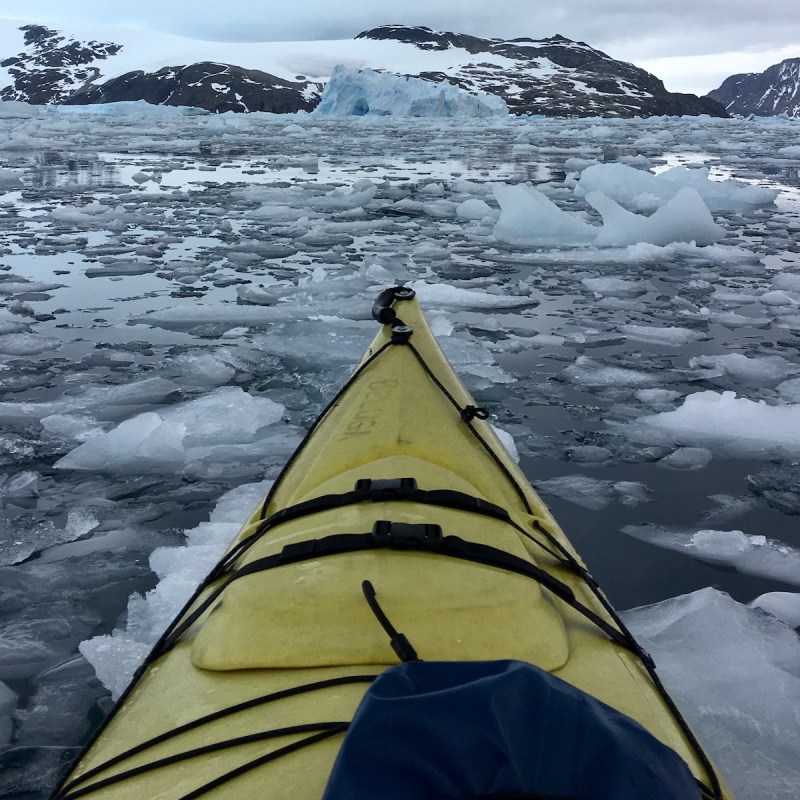
Kayaking is one of our favorite activities. We love the feel of being in the water, seeing wildlife and birds, and the relaxation of just dipping a paddle in and floating around. Since we live on a lake and own kayaks, we have endless opportunities to be on the water.
Videos by TravelAwaits
We’ve also kayaked on vacation, exploring the bioluminescent bays in Puerto Rico, kayaking around the Arcadia Bay, spotting Grizzly Bears from the waters in Alaska, and floating down the Delaware River in the Delaware Water Gap. And the highlight of a lifetime — kayaking in Antarctica.
Kayaking for us is relaxation — we are not whitewater, long-distance, or speedy kayakers. Sure, we get exercise and have done challenging kayaking, but taking in the scenery and being with the water is our principal aim.
Kayaking can be done by almost anyone. Here are some tips as you begin your kayaking journey.

1. If You Don’t Try Kayaking, You’ll Never Know How Much Fun It Is
Our first piece of advice for beginners is to just do it. If you don’t try, you’ll never discover the joy of being in the water and paddling through the stillness. Take a deep breath and go for it.
2. Start Slow — Don’t Bite Off More Than You Can Chew
Kayaking looks very easy, and it can be. However, if you’re brand new to kayaking, it’s best to take it slow. Starting off in a calm lake is much easier than taking on rapids in the Delaware River or the ocean on your first attempt.
It can be helpful to do your first trip with an organized tour or to take a lesson. That way, you’ll have somebody to teach you how to hold the paddle, turn, avoid hazards, and have the most enjoyable experience. If you do decide to do a tour, try looking for a short trip instead of jumping into a 2–3-day long adventure.
3. Learn To Paddle, Turn, And Stop
Learning to maneuver a kayak is essential. You need to know how to turn right, left, and stop or even move backward. If you take an organized tour, they’ll give you a lesson on how to do this on your first day. Some kayaks (often used by tour companies) have rudders for steering.
4. Rent Before You Buy
We had been kayaking for more than a decade before we ever considered buying a kayak. In the early years, we generally rented kayaks or joined organized tours. This had many benefits. We learned that we loved kayaking and got to experience different kinds of kayaks. Once we felt strong enough, we graduated from organized tours to renting kayaks and going out on our own. From there, we bought our own kayaks.

5. Always Go Out With A Buddy
For a very experienced kayaker, going out alone is safe enough. For new kayakers, it’s not. We always kayak together, even in the lake in our backyard. You never know when something may go wrong, and you can get yourself into a dangerous situation.
6. Don’t Forget Water, Snacks, Sunscreen, Insect Repellent, And Hats
One way to ruin a kayaking trip is to not be prepared. Being on the water in the sun means that you are exposed to the elements and can get dehydrated. Make sure to bring water, sunscreen, and a hat. We wear a rash guard so that we don’t have to reapply sunscreen frequently. If you’re going out for a long day in the water, then snacks are essential. Insect repellent will also come in handy. For getting into the boat, we wear water shoes.
7. Always Put On A Life Jacket
We always wear life jackets. It doesn’t matter if we’re only going out for half an hour or for longer. You may accidentally capsize and wearing a life jacket could be the only thing keeping you afloat. In fact, we require everyone who visits at the lake to wear a life jacket while kayaking.
8. Keep Things Dry While Kayaking
In the summer, you probably don’t mind getting wet from the spray while kayaking. But your camera, phone, and wallet won’t be so happy to be drenched. That’s where a dry bag comes in. Dry bags are inexpensive and are designed to keep things dry while in a boat or kayak. It’s an essential investment if you want to take pictures from your kayak or even just have your phone with you. These days you can even get a small protective sleeve just for your smartphone and attach a foam floater in the event your phone drops into the water.
9. Getting Into A Kayak Gracefully
The easiest way to get into a kayak is from a beach or the shallow end of a lake. You simply straddle the kayak, waddle out to the seat, put your butt into the seat, and then bring in your legs. Sounds simple, but it takes getting used to. It’s also possible to get into a kayak from a dock or a zodiac. This requires more practice, or you’ll end up in the water beside the kayak — which we’ve done more than once. Make sure to have your paddles close by as you won’t want to climb out again.

10. Buying Your First Kayak
Our first kayak was an inflatable kayak. It was inexpensive and easy to transport and inflate. It’s also easy to store. 7 years later, we still occasionally use it. We then bought inexpensive, recreational sit-in Pelican Kayaks, which are our primary kayaks today. Since our car did not have a roof rack, we had to make two very slow trips with the kayaks tied to our car to get them home.
If you buy a kayak, you’ll need to be prepared to store it during the off-season and transport it wherever you are kayaking. We have difficulty lifting our kayaks to put them on a roof rack, so make sure you’re able to do that before investing in a rack and kayak.
11. Choosing The Right Type Of Kayak
There are many types of kayaks, including touring, fishing, competition, and whitewater. Some are made for one person and others are for two (tandem kayaks). It’s best to do some research before you buy. There are sit-on-top and sit-in kayaks. If you are very tall, make sure to get a kayak that you feel comfortable in.

What Are The Benefits Of A Sit-On-Top Kayak?
With a sit-on-top kayak, you sit on top of the kayak. Your legs are exposed to the sun (make sure to put on sunscreen) and the elements. They are very easy to get on and best for warmer climates because you tend to get wet. Sit-on-top kayaks tend to be wider and easier to get back on if you should capsize. They are good for beginners.
What Are The Advantages Of A Sit-In Kayak?
Sit-in kayaks offer more protection from the elements since you sit inside. They can be more challenging to get into for a beginner, and you’ll need to make sure you feel comfortable with the size of the kayak. Sit-ins have a lower center of gravity, so they are very stable and better for control. Most sit-ins have compartments for dry bags and cup holders for drinks.
Either way, make sure that the kayak gives you enough back support or you’ll end up with a sore back.
What About Folding Kayaks?
There are a few companies that make folding kayaks. We have kayaking friends that love them. They can fit into a trunk and can be much easier for city dwellers to store.

12. Buying Your Paddles
Paddles also come in a large variety. We have paddles that come apart and are adjustable for size. They’re not very expensive and are easy to store. Make sure to select the appropriate length paddle for your kayak and your height.
13. The Importance Of A Skirt
A spray skirt is a waterproof fabric that fits around your waist and covers the opening on a sit-in kayak. It keeps you from getting wet from the spray and is important if you’re kayaking in the cold, such as in Alaska or Antarctica.

14. You Can Kayak In The Cold… With The Right Gear
You can kayak in cold weather, but it’s essential that you have the right equipment if you are considering it. We advise investing in a quality dry suit and a skirt. A wet suit will keep you warm, but a dry suit keeps you dry. In Antarctica, we kayaked with thermals underneath a dry suit. In the fall in New Jersey, we use wet suits to keep us warm. You also need to pay close attention to your hands not getting wet. Large dishwashing gloves over warm gloves can be very effective.
We have spent hundreds of hours in our kayaks, enjoying wildlife, sunset, or just floating. We hope these tips are helpful for you as you get out on the water. Happy kayaking!
